Norway R06: Anand positionally outplays Fabiano Caruana
Just past the halfway mark, things at the Altibox Norway Chess have begun to heat up. In round six two of chess world’s crème-de-la-crème succeeded in breaking through their opponent’s defenses, securing victory. While Viswanathan Anand proved his mettle yet again by convincingly defeating Fabiano Caruana, Levon Aronian continued his good form to beat the apparently out-of-shape Vladimir Kramnik. Levon is now the leader along with Hikaru Nakamura. We have detailed analysis of Anand's win with diagrams and explanations.
| Round 6: June 12, 2017 in Clarion Hotel Energy | ||
| Hikaru Nakamura |
½-½
|
Sergey Karjakin |
| Anish Giri |
½-½
|
Wesley So |
| Levon Aronian |
1-0
|
Vladimir Kramnik |
| Fabiano Caruana |
0-1
|
Vishy Anand |
| Magnus Carlsen |
½-½
|
M. Vachier-Lagrave |
Vishy Anand had been suffering from poor form in the tournament. In fact, the German GM Jan Gustafsson went so far as to count out any winning or even drawing chances for the five time world champion in his round predictions before the round.
Predictions #Altibox Rd.6:
— Jan Gustafsson (@GMJanGustafsson) June 12, 2017
MC-MVL 1-0
Naka-Kar 1/2
Lev-Kram 1/2
Giri-So 1/2
Fab-Vishy 1-0#c24live

Playing with the black pieces, he audaciously repeated the same variation of the English Opening with which he had lost against Giri in round four. The thing about Anand is that he doesn't give up on the openings that he plays. He analyzes them and tries to find improvements. And even after he loses, it is his opponents who are afraid to try out the same line because they know Vishy would be well prepared. Like in this game. Anand had lost in this line to Anish just a round ago, but he tries it once again and Caruana abstains from the same variation that Anish played.
Fabiano went for 4. Nf3 instead of attacking black’s bishop with 4. b4, as Giri had done. When the middle-game began, Anand said that he felt his pieces were placed a bit clumsily. He further added that everything could have been well for Caruana if he had been able to find a pawn break on the queen-side. Anand then found a knight maneuver to reorganize his pieces and seized a winning advantage. Caruana’s dark squared bishop, in the meantime, was jailed behind his pawns as a consequence of his opening. At one point, Caruana’s position was so bad that he couldn’t move a piece due to his structural weaknesses. Anand, on the other hand, had built up enormous pressure with his rooks lined up on the ‘f’ file.

To add to his troubles, Caruana was also in some serious time trouble around the end of the first time control. Seeing nothing better, the American stormed his kingside pawns forward to attack the black king. As Anand pointed out after the game, these pawn advances actually helped improving his own position as it just freed his pawns. By the end, Vishy was able to penetrate into his opponent’s position and carry out a mating attack. Unable to do anything against the checkmate in sight, Caruana decided that he had seen enough and threw in the towel.
Understanding Anand's strategy by IM Sagar Shah:


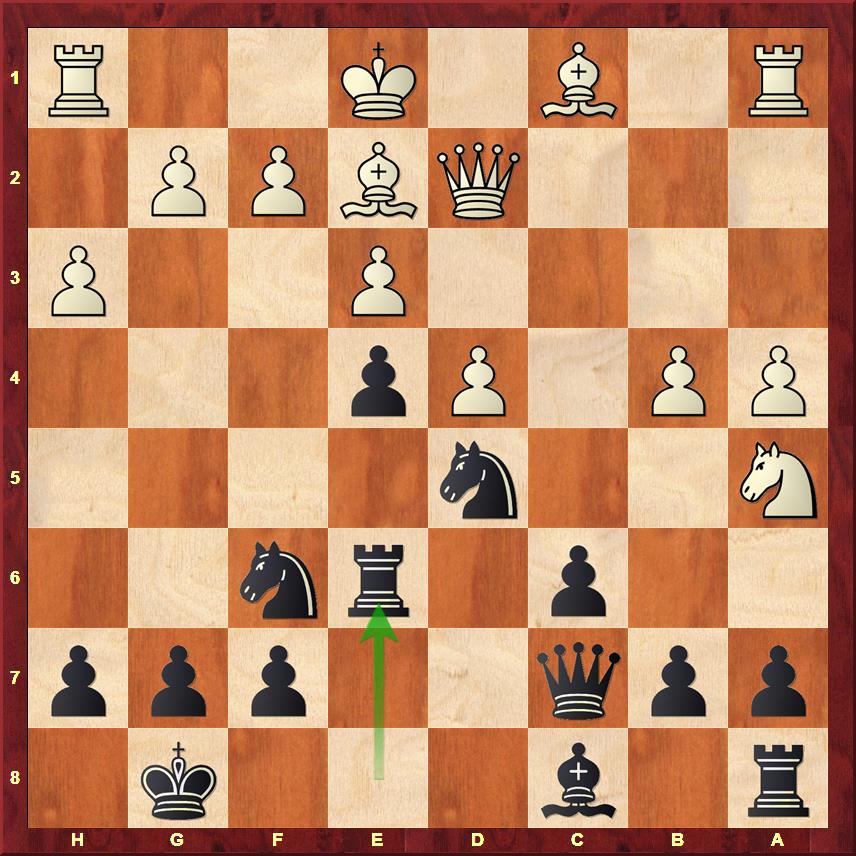
If you wonder, how does Vishy create something from nothing, then here is a move that you must study deeply. ...Re6!? The rook moves up to the third rank. It can not only be used on the kingside as shown in the game but can also be useful on the queenside if White breaks with b5.
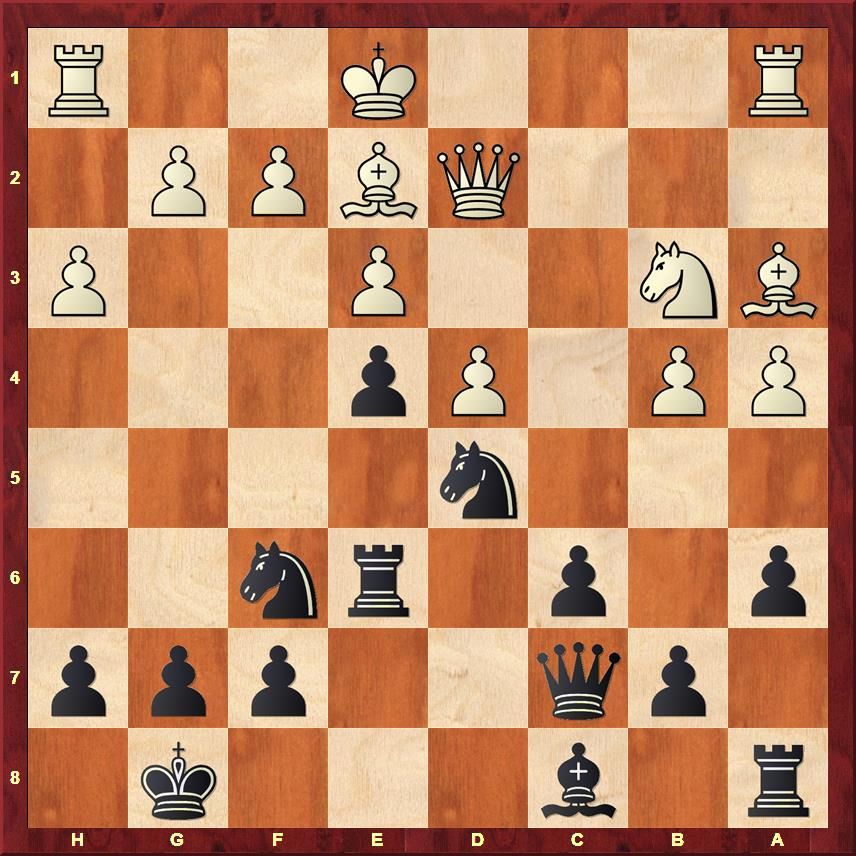
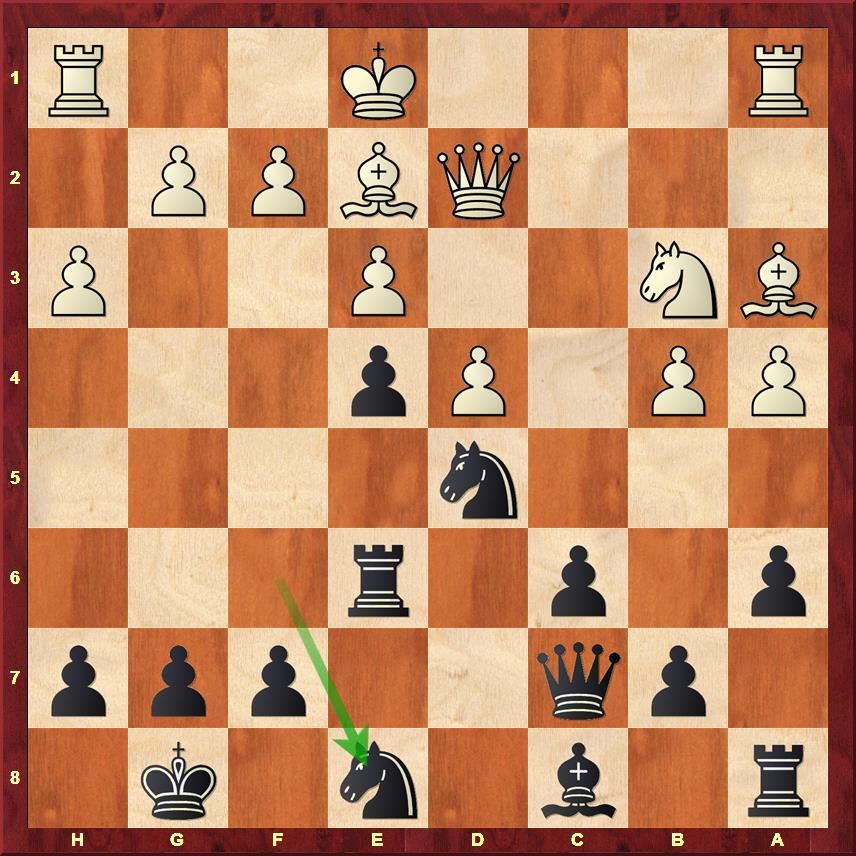
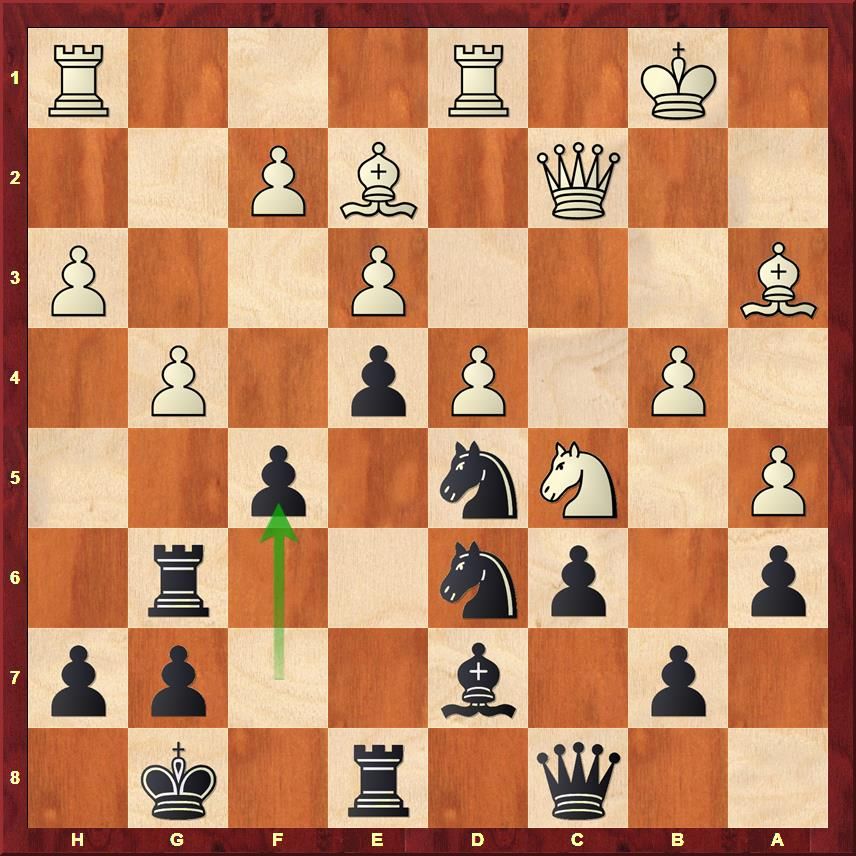
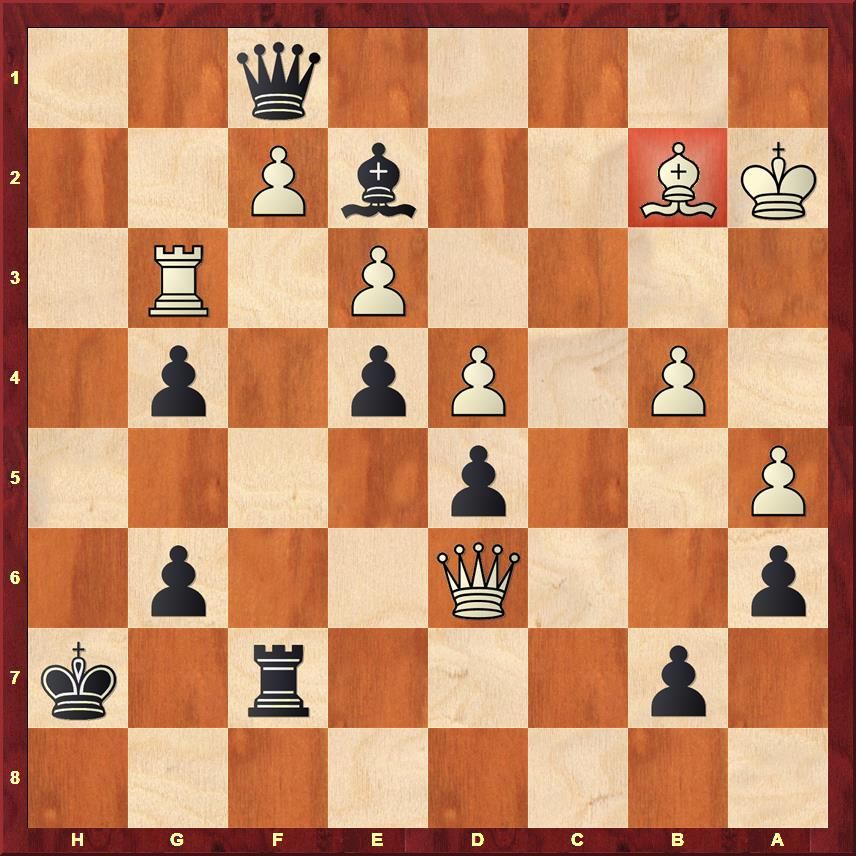
Analysis by GM Tiger Hillarp Persson:
[Site "Stavanger"]
[Date "2017.06.12"]
[Round "6"]
[White "Caruana, Fabiano"]
[Black "Anand, Viswanathan"]
[Result "0-1"]
[ECO "A21"]
[WhiteElo "2805"]
[BlackElo "2786"]
[Annotator "Tiger Hillarp-Persson"]
[PlyCount "94"]
[EventDate "2017.??.??"]
It is worth comparing what happens in the game with the not purely fictional
line:} 1. d4 Nf6 2. c4 e6 3. Nc3 Bb4 4. Qc2 O-O 5. a3 Bxc3+ 6. Qxc3 d6 7. Nf3
Nbd7 8. e3 (8. g3) 8... Re8 9. b4 e5 10. Be2 c6 {when we get a position that
will arise later in this game, but with Black to move.} (10... e4 $1)) 1... e5
{I have heard GM:s saying that the problem with the English is - in order - 1..
.e5, 1...c5 and 1...e6, and then there is nothing wrong with 1...Nf6 or 1...c6.
Further down on the list 1...b6 and 1...g6 argues about which one is the most
respectable.} 2. Nc3 ({When Mihail Marin wrote his wonderful books on the
English, he chose to recommend} 2. g3 {as the second move here. The only
downside to leaving out Nc3, is that Black can play the immediate} c6 3. d4 (3.
Nf3 e4 {is another fashionable possibility.}) 3... e4 $5 4. Nc3 d5 {and Black
seems to be doing fine.}) 2... Bb4 $5 ({Another Bb4-line arises after} 2... Nf6
3. Nf3 Nc6 4. g3 Bb4 {This line was already at the center of attention in the
classic Wch match between Kasparov and Karpov, in 1987. Their 2:nd and 4:th
game (with Kasparov as White) both went} (4... d5 5. cxd5 Nxd5) 5. Bg2 O-O 6.
O-O e4 7. Ng5 Bxc3 8. bxc3 Re8 9. f3 $1 {Lately White has been scoring very
well here and Caruana was able to score a nice win against Anand in the Moscow
Candidates 2016 (a game that has been excellently commented on in CBM by
Mihail Marin). He was possibly hoping to repeat this line.} exf3 10. Nxf3 d5
11. d4 dxc4 12. Qc2 h6 13. Bf4 Ne4 14. Rad1 Bf5 15. Ne5 Nd6 $6 16. e4 Bh7 17.
Qe2 $14 {Caruana,F (2794)-Anand,V (2762) Moscow 2016.}) (2... c6 {is not as
good here as after 2.g3, as} 3. Nf3 $1 d6 4. d4 {leaves Black with little
choice but to play either the Old Indian or a sideline of the KID.} Nd7 5. e4
$14) 3. Nd5 (3. g3 Bxc3 4. bxc3 $1 (4. dxc3 d6 5. Bg2 Nc6 6. Nf3 Nge7 {is even
nicer for Black.}) 4... d6 $1 5. Bg2 Ne7 $5 {and Black is well organized to
deal with any central set-up that White might choose. The knight is more
flexible on e7 than on f6 and it is a good reason to try Bb4 before Nf6.}) 3...
Bc5 (3... Be7 $5 4. d4 (4. g3) 4... d6 5. e4 Nf6 6. Nxe7 Qxe7 7. f3 exd4 8.
Qxd4 Nc6 {is another insteresting line, where White has to decide where the
queen is best placed. 9.Qc3 seems to be the consensus, but in a game against
Ginger GM in 2015 I came to the conclusion that e3 looked like a better square:
} 9. Qe3 O-O 10. Ne2 {This is why I didn't want my queen on c3.} a5 11. Nc3 Nb4
12. Qd2 Nd7 13. a3 Nc6 14. Nd5 Qd8 15. Qc3 f5 16. exf5 Ne7 17. g4 Nxd5 18. cxd5
Qh4+ 19. Kd1 Ne5 $2 (19... Nc5 20. Be3 Bd7 $13) 20. Bf4 $16 {Hillarp Persson,T
(2521)-Williams,S (2439) London 2015}) 4. Nf3 c6 5. Nc3 d6 {Anand reached this
position no less than five times in 2016 and obviously has a lot of faith in
its soundness.} 6. e3 (6. g3 Nf6 7. Bg2 O-O 8. O-O Re8 9. d3 (9. d4 exd4 10.
Nxd4 a5 11. b3 Bg4 12. h3 Bh5 13. Bb2 {, looks a bit better for White, to me,
but Black's pieces are active and I can understand why this kind of position
would suit Anands active style.}) 9... h6 10. Na4 Bb4 11. a3 Ba5 12. b4 Bc7 13.
e4 Bg4 $132 {Caruana,F (2820)-Anand,V (2775) 8th London Classic 2016}) (6. a3
Nf6 7. e3 (7. Na4 e4) 7... e4 (7... Bb6 $5) 8. Nd4 O-O 9. d3 d5 10. cxd5 cxd5
11. Be2 Qe7 12. b4 Bb6 13. O-O Rd8 {, was perhaps somewhat more comfortable
for White, in Topalov,V (2760)-Anand,V (2775) Champions Showdown 2016.}) 6...
Bb4 $1 7. d4 Nd7 ({It seems that Anand either has lost faith in or got bored
with} 7... Bxc3+ 8. bxc3 e4 9. Nd2 Nf6 {Nakamura played the principled} 10. Ba3
{and only got half a point out of two:} (10. f3 exf3 $6 (10... Bf5 $5) 11. Qxf3
O-O 12. h3 Qa5 13. Bb2 (13. e4 $1) 13... Qf5 $132 {Nepomniachtchi,I (2740)
-Anand,V (2775) 10th Tal Mem 2016}) 10... b6 (10... O-O 11. c5 $5 d5 12. Be2
Re8 13. O-O b5 14. Bc1 a6 15. a4 Qd7 16. f4 ({It seems to me (and the engine)
that something like} 16. axb5 cxb5 17. f3 exf3 18. Rxf3 {, intending a
sacrifice on f6, surely must be much better for White.}) 16... exf3 17. Nxf3
Ne4 18. Ne5 $6 Rxe5 19. dxe5 Nxc3 20. Qc2 Nxa4 21. e4 Qe8 22. Bd3 $2 d4 $1 {
and Black went on to win, in Nakamura,H (2775)-Anand,V (2775) Champions
Showdown 2016.}) 11. f4 $6 (11. f3 $1) 11... c5 $1 12. Be2 h5 13. Qc2 Bf5 14.
g3 Nc6 15. h3 Qd7 {and White was lucky to escape with a draw, in Nakamura,H
(2775)-Anand,V (2775) Champions Showdown Rapid 2016. Nimzowitsch could rise
from the dead just to get a chance to play this position from the black side.})
8. Qc2 {A sensible way to avoid the doubled pawn on c3.} Ngf6 9. a3 Bxc3+ 10.
Qxc3 O-O 11. Be2 Re8 12. b4 {This pawn move always make me cringe on the
inside. I'm not saying that it is bad, but when Black starts shuffling his
pieces around on the light squares it might be nice to still have this pawn on
b3. I guess there are a few GM:s who feel with me, but the majority seem to
value space more than any vague notions about light squares.} e4 $1 {[%cal
Ge5e4] This is one of those moves that you shouldn't hesitate to make. It is
clearly the best Black can hope for with this pawn structure.} 13. Nd2 d5 $1 {
This is where I first logged in to watch the games and I felt something had
gone wrong for Caruana. (...and I also felt that the b4 pawn might have been
happier on b3, so that White could play Ba3 and perhaps Qc3-b4-d6.)} 14. a4 ({
The engines love - if that is the right word - to play} 14. c5 $5 {, but
although White gets a free hand on the queenside, the same is basically true
for Black on the kingside. Also, should White choose to play 0-0-0, it is
still possible to apply the can opener with b6 and a5.} Nf8 15. h3 Ng6 16. a4
Bd7 17. b5 Nh4 18. Kf1 (18. O-O Qc8 19. Kh2 Nxg2) (18. Rg1 Qc7) (18. g3 Nf3+ $1
19. Nxf3 exf3 20. Bxf3 cxb5 {and Bc1 is a hundred miles awar from a life.})
18... h6 {and with Nf6-h7-g5 coming next, White must start wondering whether
it will be enough to get a rook down to b7? (The answer is: probably not.)})
14... dxc4 $1 {[%cal Gd5c4] If White had more pressure on e4, this would not
be recommendable, but in this situation Black is better developed, has a
wonderful square for a knight on d5 and does not have to worry about e4.} 15.
Nxc4 Nb6 $1 16. Na5 (16. Ne5 Nfd5 $1) (16. O-O Bg4 $1 17. Bxg4 Nxg4 18. h3 Nf6
19. Bd2 {and the engine wants me to believe that the position is almost equal.
Well... after} Nfd5 20. Qb3 Nxc4 21. Qxc4 Re6 22. b5 Qd7 23. Qb3 a6 $1 24. bxc6
Rxc6 25. Rfc1 Rac8 {I would under no circumstances want to play the White side.
}) 16... Nbd5 (16... Nfd5 17. Qd2 Qg5 {looks very promising too.}) 17. Qd2 Qc7
18. h3 Re6 $5 {[%cal Ge8e6] A lovely move that has more than one function. ON
one hand it is ready to attack the kingside at any moment, but also it might
come in handy if White continues with b4-b5.} 19. Ba3 (19. Nc4 Ne8 20. b5 cxb5
(20... a6 21. bxa6 b5 $5) 21. axb5 Nd6 22. Nxd6 Rxd6 23. Bb2 Rg6 24. Rc1 Qd6
25. Kf1 Be6 26. Rc5 Qd7) ({White's natural plan is to play b4-b5, but when
Black's pieces are so well organized and active, it tends to backfire:} 19. b5
$6 cxb5 20. axb5 Bd7 $1 21. Ba3 b6 22. Rc1 Qb8 23. Nc6 Qe8 {and pawns will
fall.}) 19... a6 20. Nb3 $6 {This knight is feeling a bit lost. It was well
placed on a5, but there was no way forward. Now it seeks greener pastures, but
it turns out to be no better than the last one. In the mean time Anand
improves his forces coordination further.} Ne8 $3 {[%cal Gf6e8] Another great
move. From d6 the knight keeps and eye on e4, c4 and f5, while it makes b4-b5
harder to play for White. It also opens the road to g6 for the rook. You
cannot ask for more of one move.} 21. Nc5 Rg6 22. g3 ({It's horrible to leave
the f-pawn behind in this way, but} 22. Kf1 Nd6 {was not an option.}) 22... Nd6
23. a5 {This move looks like a sign of desperation. Not only does White give
up all future counterplay on the queenside, but also the bishop on a3 gets
completely entombed. I would normally give such a move a "?!", but I trust
that Caruana had better reasons that my engine and I can whip up in five
minutes.} Bf5 $1 24. Qc2 Re8 25. O-O-O Qc8 (25... Ra8 $5) 26. g4 Bd7 27. Kb1 f5
$5 {[%cal Gf7f5]} ({There is some kind of mute, unformulated guideline, that
tells me to attack the g4-pawn with} 27... h5 {rather than move the f-pawn.
Perhaps it is because I prefer to keep my pawns in one long chain. However, in
this position, Anands choice makes even more sense as it opens the f-file
towards f2.} 28. Rh2 hxg4 29. hxg4 Bxg4 30. Rdh1 f5 $17) 28. gxf5 Rf6 29. Rdg1
Bxf5 30. h4 Ref8 31. Rh2 Kh8 {It seems that Anand is keeping the tempo up as
Caruana feels the pressure from the clock.} ({Here I see no defence against}
31... Qc7 32. Rhg2 Bc8 $1 {and the f2-pawn falls:} 33. Bc1 (33. Bd1 Nb5 $19) (
33. Bf1 Qf7) (33. Rxg7+ Qxg7 34. Rxg7+ Kxg7 {is utterly hopeless for White who
has only one active piece.}) 33... Rxf2) 32. Qd2 Rg6 33. Rxg6 hxg6 $5 {This
makes things a bit harder, but in time pressure it is almost impossible for
White to find the defence.} (33... Bxg6) 34. h5 $1 g5 35. h6 g6 36. Bb2 $6 {
After this move White is irreversibly lost. The only chance was to try to
exchange Be2 for another piece than Black's bishop:} (36. Bd1 $1 Bg4 37. Bb3
Bf3 $1 38. Qc1 {and White can try something with Bxd5 and then queen to g3.
Still, Black should win with g4 and then Rf8-f5-h5.}) 36... Bg4 $1 37. Bf1 Kh7
38. Ka1 Bf3 {To quote Italo Svevo, White's position has become the "tomb of
its (sic) good intentions". The rest is just a demonstration of how helpless
White is.} 39. Rh3 g4 40. Rg3 Rf5 41. Na4 Qf8 42. Nb6 Qxh6 43. Nxd5 cxd5 44.
Qc1 Qh1 45. Qc7+ {This loses fast, but everything else loses almost as fast.}
Rf7 46. Qxd6 Qxf1+ 47. Ka2 Be2 {[%csl Rb2][%cal Gf3e2] White has no way to
deal with Bc4+, followed by Qd3, so he resigned.} 0-1

The other decisive game of the round was played between Levon Aronian and Vladimir Kramnik. Although the Russian veteran, Vladimir Kramnik, had had a decent run in the tournament so far, yesterday was just not his day. Kicking off with a Semi-Tarrasch as a counter to Aronian’s 1. d4, he started playing poorly soon after the opening. Things really started going south for him after his errors on moves 15 and 19. Aronian was simply able to trap his opponent’s queen. In order to be able to exchange his trapped queen for white’s queen, Kramnik had to give up an exchange and the resulting position was a totally lost one. Talking to GM Nigel Short after the game he said, “I made around two or three blunders. That’s a bit too much for one game”.
Analysis by GM Daniel King:

Despite having lost against Nakamura in the very first round, Anish Giri has put up a decent show so far and climbed up the tournament leaderboard. In yesterday’s game, he was pitted against the American number one, Wesley So. Starting off with a Symmetrical English, the Dutchman was able to seize a decent advantage and was pressing throughout the game. At one point, he had almost trapped black’s light-squared bishop – surprisingly enough – on the longest diagonal of the board. But unable to find a way to win the trapped piece, Giri went for the endgame with an extra pawn. Wesley, however, made the most of the fact that this was a complicated rook endgame and was able to force a draw by repetition after 59 moves of play.
In the game Nakamura-Karjakin, neither player was able to pose too many problems to his opponent in a 54-move-long Nimzo-Indian.

Maxime Vachier-Lagrave was also able to hold Magnus Carlsen to a draw fairly easily with the black pieces. Although the World Champion is hungrily looking for his first win in this event, the Frenchman defended stubbornly until all piece were hacked off the board and only kings remained.
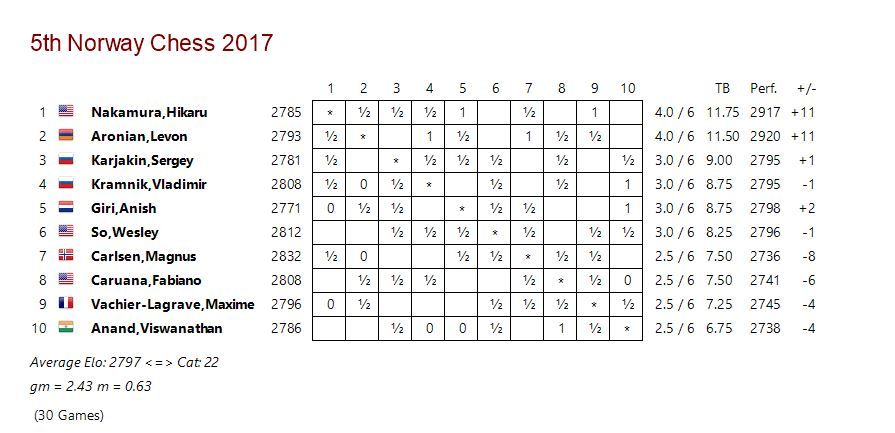
There were quite a few changes to the standings at the end of the sixth round. The most important of them was that Levon Aronian has now joined Hikaru Nakamura in the lead with 4.0/6. After his loss today, Vladimir Kramnik has been joined by So, Giri and Karjakin on the second spot with a score of 3.0/6.
With his win today, Anand has moved up to a shared third place along with Magnus Carlsen, Fabiano Caruana and Maxime Vachier-Lagrave. They have all scored 2.5/6 each. With just three more rounds to go, Anand is going to have a tough time as he will be facing the tournament’s co-leader Hikaru Nakamura in the next round. The good thing is that he will have the white pieces and a rest day before he faces Naka. In that way, his win in this round has come at a perfect time and might just catapult him higher up the tournament leaderboard.
Replay all the games:
Coverage on Firstpost:
Firstpost and ChessBase India have collaborated to bring you extensive and detailed coverage of the chess scene in India and internationally.

R1: Altibox Norway Chess: Viswanathan Anand should be buoyed by draw with black pieces in 1st round
R2: Altibox Norway Chess: Viswanathan Anand hurt by misjudgment against Vladimir Kramnik in 2nd round
R3: Viswanathan Anand up to the task as Sergey Karjakin tests his memory, preparation
R4: Altibox Norway Chess: Viswanathan Anand's position grim after 2nd loss, but can't count him out yet
